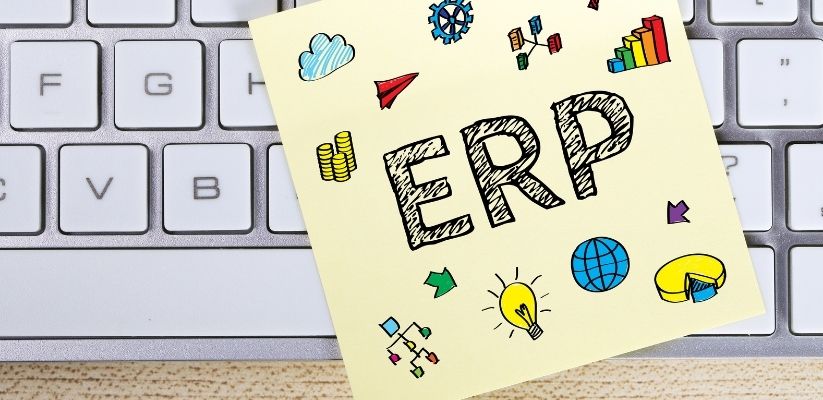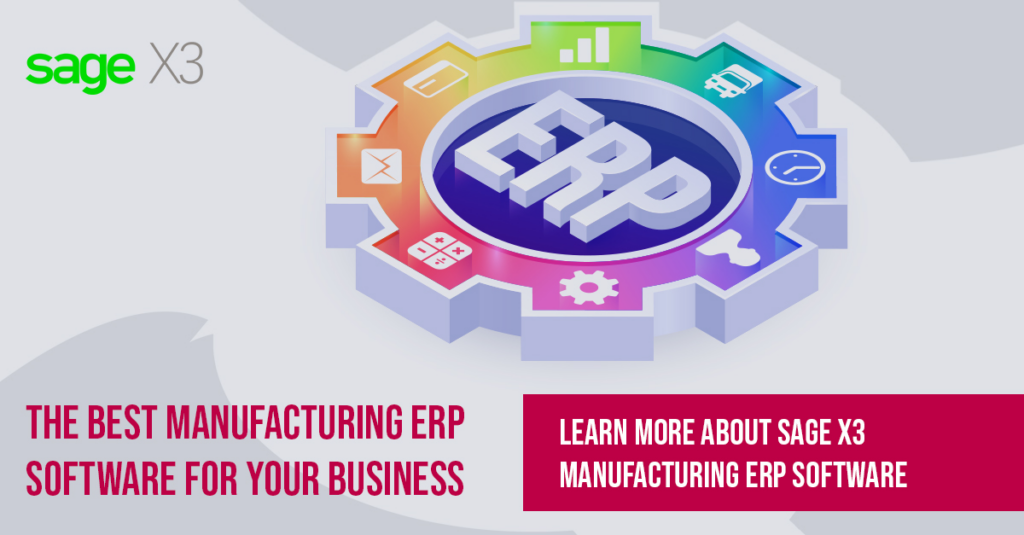Summary: Full-scale ERP implementation is a resource-heavy process that takes a significant amount of time. It involves transferring critical business data into secure data repositories, monitoring the implementation process to find inefficiencies and loopholes, and providing extensive training to end-users who will eventually use the software. However, if you efficiently execute the parameters mentioned above, your ERP implementation process will be successful.
This article will focus on the seven crucial steps in the ERP implementation plan by providing critical resources, information, and templates to help you in the process.

1. Create a dedicated ERP project team
Begin by creating an ERP project team that will oversee the entire implementation process. Its primary duties will involve:
- Ensuring the implementation process is going according to the plan.
- Ensuring end-users have the required knowledge to operate the software independently.
- Making sure that critical business data is stored inside multiple repositories.
- Hearing and solving challenges that employees face during the ERP implementation phase.
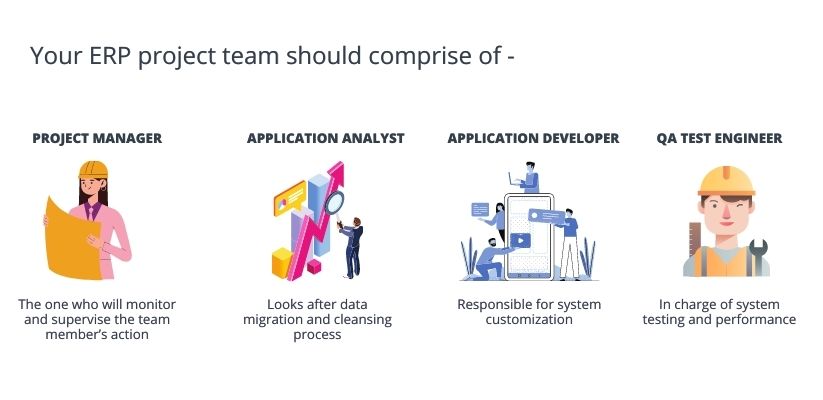
ERP implementation process is a resource-intensive and time-taking exercise that requires collective efforts from each department.
The infographics below show a few examples of stakeholders you should include while implementing the ERP software.
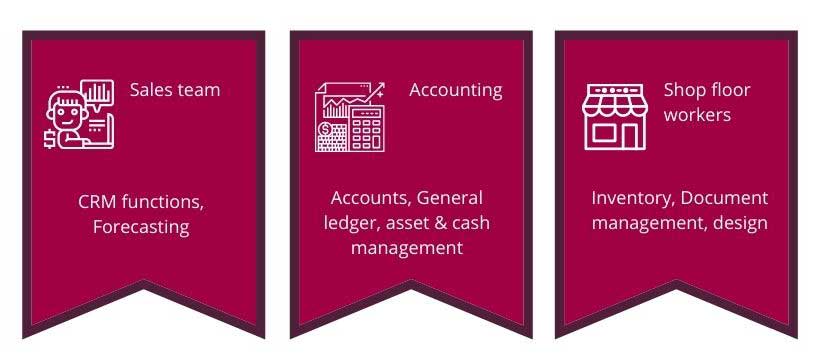
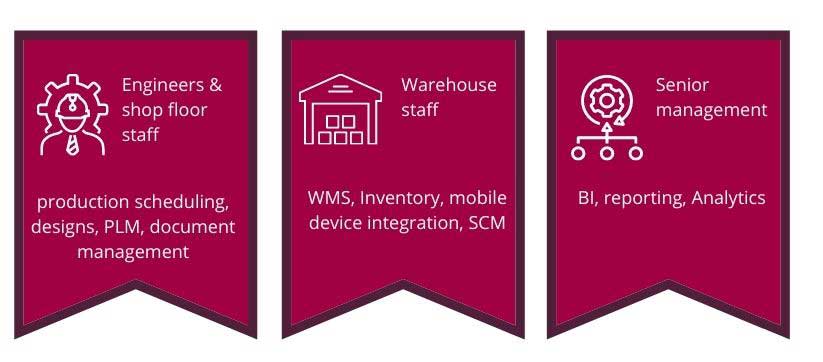
Should you take the services of an implementation consultant?
Hiring makes sense if you don’t have an in-house ERP expert. An experienced ERP implementation consultant has rich experience solving complex challenges that might show up during the implementation phase. But hiring one can become a problem if your finance department is tight-fisted.
2. Brainstorm an ERP implementation change management strategy
Remember the following points while designing the ERP implementation blueprint.
- Deciding the implementation budget
- Developing the ERP implementation schedule
- Migrating critical business data to the new ERP system
- Giving adequate training to the end-users of your ERP
- Testing the ERP software, identifying the loopholes, and making last-minute changes
- Going live
- Evaluating the project’s success
Another crucial thing is that ERP implementation might disrupt the normal functioning of your organization for some time. But you can reduce the impact by:
- Communicating expected disruptions.
- Providing enough time for user training.
- Identifying the needs of all business stakeholders
3. Drafting a viable budget for ERP implementation
Forecasting the ERP implementation cost is a complicated question to answer. Many companies struggle to keep the implementation costs in check because only a few managers volunteer to manage the project.
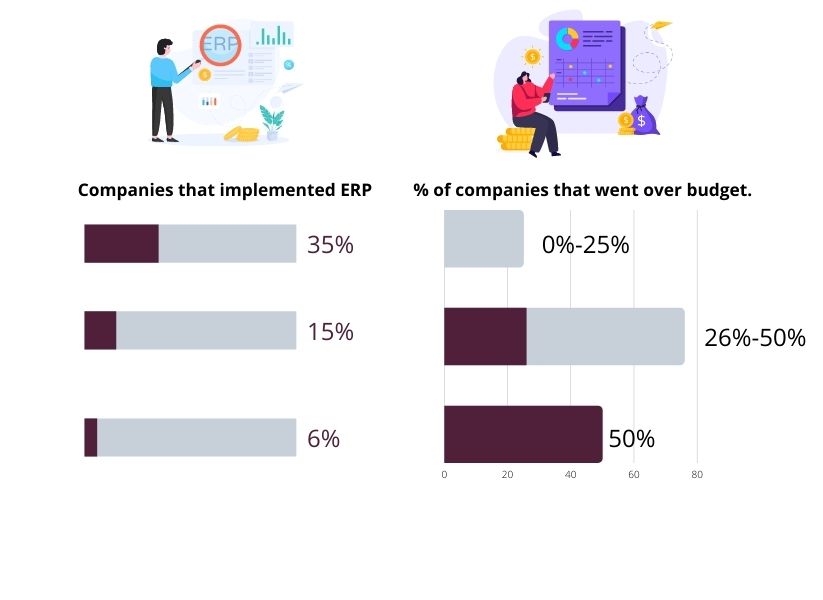
The above infographic suggests that more than half of ERP implementations exceeded their budget. Therefore, you should consult with numerous experts before finalizing a budget.
An excellent point to begin will be by assuming that the ERP implementation cost will be at least 1% of the organization’s yearly gross revenue. Other factors that will impact the cost are:
- Paying for extra work hours: Your employees won’t be happy to know that you will not pay them for the extra hours they are putting in.
- New software/hardware upgrades: Carve out a bigger budget for upgrades if you decide to implement an on-premise system.
- Data storage and backups: You will get new upgrades for free with your cloud ERP system but remember to cross-check.
- ERP customization and vendor training: Prefer vendors that provide employee training, customized modules based on your company’s requirements and charge less fees.
Your ERP implementation cost will depend on multiple factors like business size, the number of users, industry type, infrastructure cost, and many more.
According to a recent report by softwarepath, the average cost per user for an ERP project is USD 9000 in 2022.
Also, remember that all your business departments will experience productivity loss during the implementation phase irrespective of how hard you try. So, get ready to bear some disruptions and loss in efficiency.
<<<Also Read: Why ERP implementation is a challenging task?>>>
4. Focus on data migration
The actual implementation begins from the data migration stage, where you migrate your business-critical data to the new ERP system. You need to be extra careful during this stage because you will have a solid foundation to carry the implementation forward if you do it right. If not, the implementation will fail, and you will lose time, effort, and money.
The application analyst will supervise this stage. Go through the infographic below to understand further.
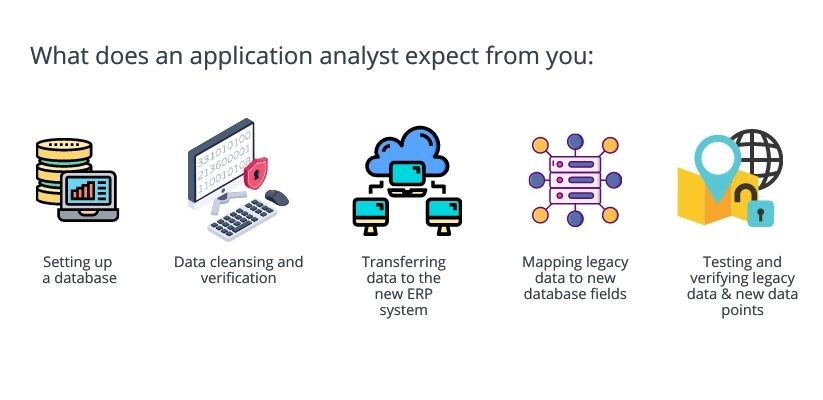
5. ERP user training
A suitable user training plan is critical to ensure your ERP implementation turns out to be successful. This training can be divided into two categories, namely “in-person” and “e-learning”.
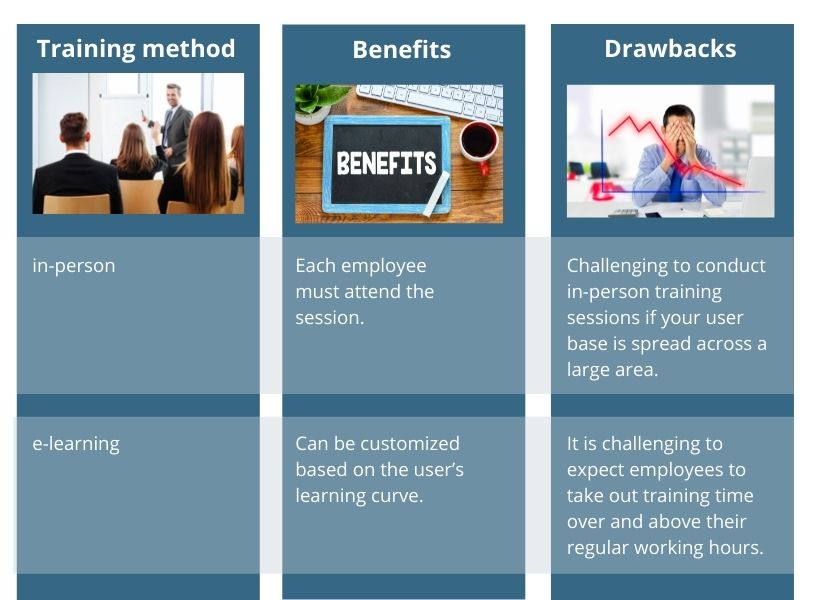
Here are four essential features of all successful training programs irrespective of the training methods you implement:
- Collect feedback from trainees and the implementation team to improve the entire training session.
- Start multiple communication channels, including vendor support teams that allow trainees to solve their doubts instantly.
- Create role-based training programs that can be customized based on the user’s learning curve.
- Include tech-savvy people in the training session who help low-level users during the initial days.
Gamifying the training lectures can be of great help. According to a survey by TalentLMS, 89% of surveyed people say that a point-based system will boost their engagement. Another 62% say that a competitive environment with a ranking system will motivate them to perform better. You can use these statistics to your advantage by building a suitable platform for addressing user needs.
6. Extensively plan before going live
The go-live stage of ERP implementation is the most difficult as it requires significant effort and time investment by the whole team.
The list below shows what you need to plan on the go-live day:
- System testing to ensure everything is going according to the plan (both pre and post-go-live sessions)
- Staff scheduling to ensure you have the required number of employees at your disposal.
- Listing critical parameters to evaluate the success of the project.
- Brainstorming an appropriate communication strategy for managing system downtime.
- Ensuring network speed is up to the mark so that the system doesn’t suffer any lag.
- Making sure that multiple copies of critical business data are available.
Communication plays a pivotal role while going live and after the implementation process is complete. Therefore, you should develop a flawless communication platform for sharing crucial information and solving technical issues as and when they arise. In addition, it will also help monitor who is doing what and track the goal completion rate.
7. Analyzing ERP implementation success rate
Ask yourself the following questions:
- Has your company exhausted a significant amount of funds in the ERP implementation process?
- How helpful your ERP vendor has been during the implementation journey?
- Has the vendor breached any clause in the contract?
- How conversant is the end-user with the new ERP software?
Other metrics involve the following:
- Have human errors gone down: The automation feature of ERP software decreases human-induced errors. Therefore, an essential parameter to track the effectiveness of the ERP implementation process is to check whether employees are making fewer errors or not.
- Has the ROI increased: Check the ROI of the entire ERP implementation process. Are you seeing a return on your investment, or are you making losses?
- Have the productivity levels increased: The primary objective of the ERP implementation process was to increase the end-users productivity. Did you achieve that?
- Has the client satisfaction level gone up: Are you processing customer orders quickly? Has the client satisfaction score increased?
Remember that every company is different. Your requirements, short-term goals, long-term objectives, customer base, and the resources you have are different from your competitors. Therefore, ERP implementation techniques, schedules, templates, and success parameters will vary across companies and industries.
STAY UPDATED
Subscribe To Our Newsletter
At Sage Software Solutions (P) Ltd., we are home to world-class ERP software and CRM software that will solidify your business tech support fundamentals and enable you to build a customer-centric organization. You can also write to us at sales@sagesoftware.co.in.
Disclaimer: All the information, views, and opinions expressed in this blog are those of the authors and their respective web sources and in no way reflect the principles, views, or objectives of Sage Software Solutions (P) Ltd.
